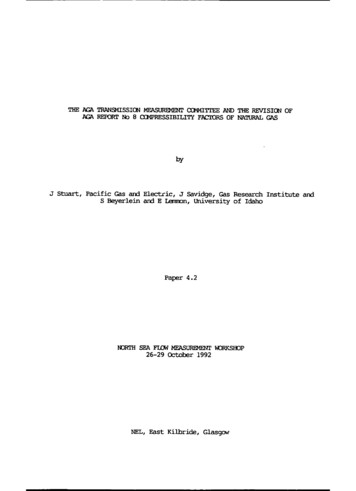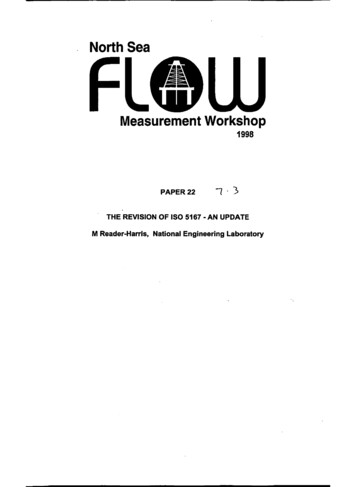
Transcription
I--IIIIIitIIIITHE NlA TRANs-ITSSIOO ME'ASUREMENl' CXMIITI'EE AND THE REVISIOONlA REPORT No 8 CXMPRESSIBILITYFJ\C'IORS OF NATURAL GASbyJ Stuart,Pacific Gas and Electric,J Savidge, Gas Research InstituteS Beyerlein and E Lamon, University of IdahoPaper 4.2IeIIIIIIIIOFNJRTH SPA FI.lM MEASUREMENl'26-29 NEL,East Kilbride,IDRKSHOP1992Glasgowand
I.IIIII"IIIIIeIIIIIIIIThe AG.A Transmission Measurement Committee and the Revision ofAG.A Report No.8 on Compressibility Factors of Natural GasJohn StuartChairman, Transmission Measurement CommitteePacific Gas and ElectricJeff SavidgeGas Research InstituteSteven Beyerlein and Eric LemmonUniversity of IdahoSUMMARYIn the United States and Canada, there are several organizations that are directlyinvolved in improving the understanding and practice of natural gas measurement.One of these organizations, the AG.A Transmission Measurement Committee, isdescribed in this paper. This paper also discusses the results of a recently completedproject of that committee, the 1992 revision to AG.A Report No.8 onCompressibility Factors of Natural Gas. As part of this discussion, two newcompressibility calculation methods will be compared to each other and to theNX-19 method for a reference Ekofisk Gas as well as two gas compositions found inthe North Sea.1.FLOW MEASUREMENTORGANIZATIONSIN TIlE U.S.The following is a list of the major U.S. organizations directly involved with theresearch, testing, technical recommendations, standards, and regulatory matters ofnatural gas measurement.AG.A/ TMC / DMC American Gas Association / TransmissionMeasurement Committee / DistributionMeasurement CommitteeAPI / COPM / COGM American Petroleum Institute / Committee onPetroleum Measurement / Committee on GasMeasurementASME/MFCASTMAmerican Society of Mechanical Engineers /Committee on Measurement of Fluid Flow mClosed ConduitsAmerican Society for Testing and MaterialsGPAGas Processors AssociationGRIGas Research Institute
.'.2.THE AMERICANIGAS ASSOCIATIONThe American Gas Association (AG.A) is a national trade association with amembership from 250 natural gas distribution and transmission companies locatedthroughout the United States and Canada, as well as overseas.IThe AG.A staff consists of approximately 180 people located in Arlington,.Virginia.just across the Potomac River from Washington, D.C. Another 180 peoplework in the AG.A Laboratories, Cleveland, Ohio, testing and certifying gasappliances. AG.A's annual budget is approximately 50 million, supported bymember dues, testing fees, conference registrations, publication sales and othersources.IIIThe AG.Acommittees are organized into four sections:1. Legal Section2. Marketing Section3. Financial and Administrative Section4. Operating and Engineering SectionEach section has several committees made up of member company experts. Thesecommittees typically meet two or three times a year to discuss mutual problems,share solutions, produce recommended practices and/or standards, and formulategas industry policies. AG.A's government relations and communications staff thenstrive to effectively communicate these policies, etc. to legislators, regulators, andindustry. For example, AG.A spends about 15 million per year on nationaladvertising, describing the benefits and advantages of natural gas to our customers.The AG.A Operating and Engineering Section consists of about 700 technicalexperts representing their individual companies, on 17 different committees.Ct!mmitteeAutomation and ControlCompressorCorrosion ControlCustomer Service and UtilizationDistribution, Construction and MaintenanceDistribution EngineeringDistribution MeasurementEnvironmental MattersFleet ManagementGas ControlMaterials ManagementPipelinePlastic MaterialsSafety and Occupational HealthSupplemental GasTransmission MeasurementUnderground StorageMembers382829406340354644353031683737TOTAL 4940690--IIIItI IIIIIII
I.IIIIIt'IIIICommittee activities and projects are aimed at addressing a set of key industryissues: saftey, regulations/standards, environmental, communication, GasEngineering ana Operating Practices Series of books, technology, third partydamage, quality and productivity improvement, and research identification.IIICOMMIn EE(TMC)The TMC consists of 20 members from transmission and distribution companies,and 26 associated members from manufacturing, research, and educationalinstitutions.The scope of projects covered by the TMC include the procedures and practices forinstalling, operanng, testing and maintaining metering and associated equipment,including volume and pressure control equipment which is used in the production,gathering and transmission of natural and substitute gas from the source to theoutlet of a transmission line ate station. Also included in the scope of TMCactivities are the scientific pnnciples, applications and usage of all types ofvolumetric, weight, and energy measurement devices associated with the meteringequipment specified above.The current three year plan for the TMC includes the following projects:1.2.3.4.5.6.IeIIIIImE A.G.A TRANSMISSION MEASUREMENT3.4.Revise A.G.A. ReportRevise A.G.A. ReportRevise A.G.A. ReportQuality Clauses.Develop a small Fieldon Orifice Metering.No.8 on the Compressibility Factors of Natural Gas.No.7 on the Measurment of Gas by Turbine Meters.No. 4A on Natural Gas Contract Measurement andGuide for the new revision of A.G.A. Report No.3:Continue to provide direction to the research community to ensure resultshave value to members.Provide tehcnical support to other organizations revising measurementstandards, e.g. API, GPA, etc.THE REVISION OF A.G.A REPORT NO.8As an example of a recent TMC project, the remainder of this paper will describe amajor project just completed, the revision of A.G.A. Report No.8, CompressibilityFactors of Natural Gas and Other Related Hydrocarbon Gases. This report is inthe final stages of review and will be available to users in the gas industry inDecember 1992. This report is based on a large amount of supporting researchconducted in North America under the sponsorship of the Gas Research Instituteand in Europe under the sponsorship of the Groupe Europeen de RecherchesGazieres (GERG), Gasurue, Ruhrgas, Gaz de France, and British Gas. The reportwill be accompanied by a diskette of FORTRAN subprograms as well as a utilityprogram for calculating compression factors based on a variety of inputs.
I.4.1BackgroundDuring the period 1981-1984, the AG.A through its Transmission MeasurementCommittee and the GRI sponsored development of an equation of state to providetile gas industry with state-of-the-art predictions of compressibility factors fornatural gas metering applications. Initial work used data ranging in pressure up toapproximately 6 MPa obtained from the literature and provided by the GERG.However the GERG data bank was extended considerably in the period 1985·1990 .The new data showed that the original equation developed in the period 1981·1984needed improvement. In addition, velocity of sound data obtained under GRIsponsorship during 1985-1989 showed calculations for rich gases were notsufficiently accurate for critical flow applications, These data were included in anew thermodynamic property correlation for natural gas mixtures. The resultingequation of state is referred to as the Detail Characterization Method and isdocumented in AG.A Report No.8.4.2Natural Gas CharacterizationMethodsTwo highly accurate models for computing compressibility factors in gasmeasurement applications are presented in AG.A Report No.8. One modelapplies a detailed knowledge of natural gas composition to compute thecompressibility factor (i.e. usin standard composition information from achromatographic analysis). This is the Detail Characterization Method and can beapplied over a wide temperature, pressure, and composition regime. A secondmodel applies an aggregate or gross knowledge of natural gas composition tocompute the compressibility factor. This model is the Gross CharacterizationMethod which was developed under sponsorship from the Groupe Europeen deRecherches Gazieres (GERG). The method can be applied within the custodytransfer region which extends from 265 to 335 K at pressures less than 12 MFa.Nei ther model is recommended in the liquid phase or within 5K and 0.2 MPa of thecritical point.The Gross Characterization Method was developed by GERG and modified forimplementation in the U.S. These modifications have to do with the specification ofreference conditions for metering and for determination of heating value. TheDetail Characterization Method was developed using a three ste!? procedure usingcompressibility factor data obtained from the literature and provided by GERG.(1)(2)(3)First, an equation of state for key pure components was developed usingcompressibility factor data for methane, ethane, nitrogen, hydrogen, andcarbon dioxide along with velocity of sound data for methane. The equationof state terms were chosen using a procedure which minimizes the number ofterms required for a given accuracy,Second, compressibility factor data for key binary mixtures were used todetermine binary interaction parameters for key binary component pairs.Third. the GERG compressibility factor data for 84 natural gas mixtures wereused to evaluate the accuracy of the equation of state for natural gascompressibility factors. In addition, velocity of sound data measured by NlSTfor four natural gas mixtures were used to evaluate tile equation of state forvelocity of sound predictions.The Detail Characterization Method and the Gross Characterization Method havebeen incorporated into efficient computer programs for computing theIIIII--IIIIJIIIIIIII
I.IIIIIt'IIIIIeIIIIIIIIcompressibility factor, Z, the mass density, o, and the supercompressibility factor,Fpv. The programs have been designed for the following purposes: (1) efficientimplementation on flow computers, (2) as a guide for the development ofapplication programs in the gas industry, (3) for computational verification; and (4)for utility purposes such as tabulating Z, p, or Fpv for particular gas mixturecompositions.4.3Reference Data for Natural Gas MixturesDuring the last two years the Gas Research Institute in coordination with Gasunie,Ruhrgas, and Gaz de France have sponsored highly accurate measurements ofnatural gas mixtures at the Nationallnstitue for Standards and Technology (NIST),Texas A&M, Van der Waals Laboratory, and Ruhrgas. PVT data for the fivenatural gas mixtures shown in Figure 1 were obtained in this research. All mixtureswere gravimetrically prepared and chromatographically verified by NIST and thensent to each of the participating laboratories. Density measurements were takenover temperatures from 225 to 350K and at pressures up to 70 MPa. These"reference data" represent the state-of-the-art in PVT measurements for natural gasmixtures. Intercomparison of the data shows an average agreement between theexperimental measurements from the four laboratories of O.035%. These PVTreference data were acquired after finalization of the Detail CharacterizationMethod and the Gross Characterization Method. As such, these data provide anindependent verification of both characterization methods.Figure 2 compares PVT reference data for Ekofisk gas with density predictions fromthe Detail Characterization Method as welI as the Gross Characterization Methodat 275K and 300K. Density deviations are calculated as,(Pdata - Peale)/ Pdata 100.(1)Figure 3 compares density predictions from the Gross Characterization Methodagainst those from the Detail Characterization Method for Ekofisk Gas. Densitydeviations are calculated as,(Pgross - Pdetail)/ Pdetail 100.(2)Despite the agreement in predicted densities, these methods give significantlydifferent derived properties such as velocity of sound and heat capacity. Figure 4compares density predictions from the NX-19 Method against the DetailCharacterization Method for Ekofisk Gas. Density deviations are calculated as,(PNX-19 - PdetaiJ)/ Pdetail 100.(3)Both the Detail and Gross Characterization Methods represent the density EkofiskGas within 0.05% at pressures less than 12 MPa, while the NX-19 Method is in erroras much as 2%. As the concentration of heavier hydrocarbons increases, thedifferences in predicted density between all three methods becomes morepronounced. Molar composition of natural gas from two North Sea fields is given inFigure 5. Fi re 6 compares density predictions from the Gross CharacterizationMethod against the Detail Charactenzation Method for the Statfjord Gas. Figure 7compares density predictions from the NX-19 Method against the DetailCharacterization Method for Statfjord Gas. Figure 8 compares density predictionsfrom the Gross Characterization Method against the Detail CharacterizationMethod for Veslefrikk Gas. And Figure 9 compares density predictions from the
I.INX-19 Method against the Detail Characterization Method for Veslefrikk Gas.Figures 6-9 illustrate that the Detail Characterization Model should be favored inpredicting compressibility factors for rich gas mixtures such as those found in theNorth Sea. Unfortunately, little reference quality experimental data are availablefor evaluating the accuracy of compressibility factor predictions for rich gasIIIImixtures,4.4Recommendationto Gas Industry UsersIn the United States the Gross Characterization Method will be implementedprimarily for transmission/distributionsystem applications. This method will onlybe used for compressibility factor calculations. All derived physical properties willbe calculated with the Detail Characterization Method. The Detail.Characterization Method is applicable to transmission/distributionconditions and isexpected to be applicable to a broad range of production/processing conditions.Research is underway to investigate the data and modeling needs for heavier gasconstituents. REFERENCESSTARUNG, K.E. and SAVIDGE, J.L, "Compressibi
THE REVISION OF A.G.A REPORT NO.8 As an example ofarecent TMC project, the remainder ofthis paper will describe a major project just completed, the revision ofA.G.A. Report No.8, Compressibility Factors ofNatural Gas and Other Related Hydrocarbon Gases. This report is in the final stages ofreview and willbe available tousers inthe gasindustry in











